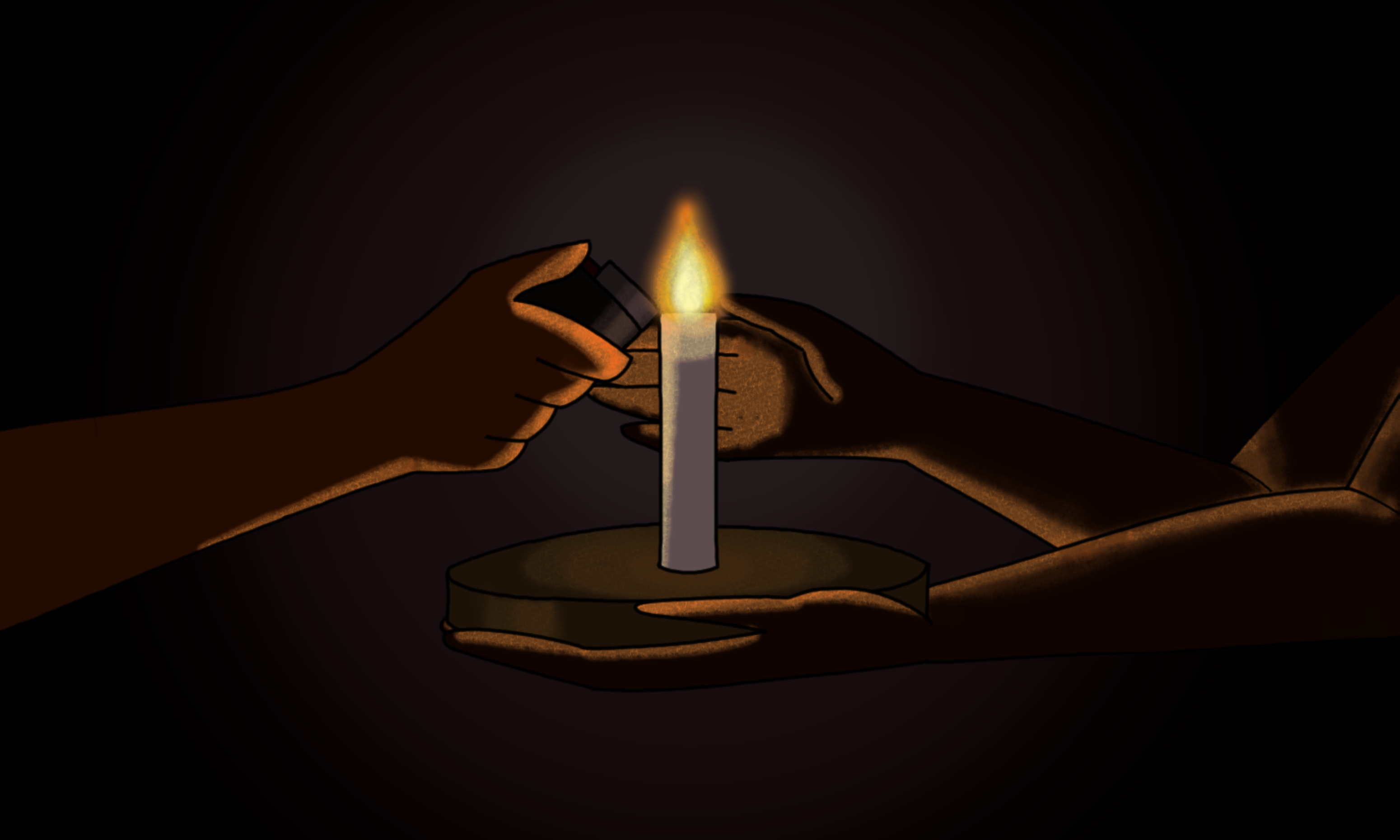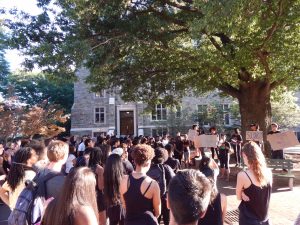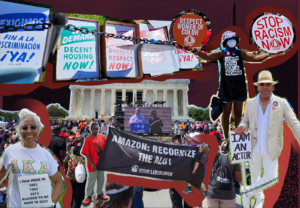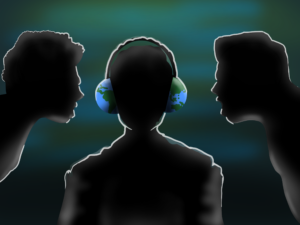Content warning: This article discusses anti-Black systemic violence.
Attacks on Black lives are ubiquitous. It has been nine months since Tyre Nichols joined an ever-growing list of names we vow to say and remember. Every name on that list of Black lives ended by racism and police brutality comes with hope that things will change—that, perhaps this time, enough is enough. Some of us may have felt that with George Floyd, Michael Brown, Rodney King, or Emmett Till, yet the list of names keeps growing. This unrelenting disappointment is a huge source of burnout for many.
Systemic racism and anti-Black violence pervades institutions—and Georgetown is no exception. On April 29, 2022, a student—whose identity Georgetown’s administration still protects—committed a hate crime against LaHannah Giles (CAS ’23). After months of student organizing calling on Georgetown to repair its initial miscarriage of justice, the University failed to implicate the guilty student due to its irresponsible loss of crucial evidence. This failure has forced students, especially Black students, to relive the same feelings of pain and disappointment.
Faced with Georgetown’s mishandling of the hate crime and the news of Tyre Nichols’s murder, Georgetown’s Black community has taken steps to process collective grief. However, we acknowledge that the Black community has had to respond to these injustices with little institutional or outside support. What responsibility should the student body and the administration bear in the face of instances of violence against communities of color? And especially considering Georgetown’s deep-seated anti-Blackness, how should non-Black students show up for their Black peers?
The Editorial Board believes that we must reimagine our role as Georgetown students in fighting for justice in the American political sphere.
Organizing is labor, and both here at Georgetown and nationally such labor has disproportionately fallen on BIPOC communities which are already burdened by racial violence. The fact that the labor of on-campus organizing has fallen mainly on students of color is an ironic and tragic reality at a PWI known for its self-proclaimed “politically-conscious” students. The Editorial Board asserts that it is the responsibility of each of us, especially white students, to first reflect on where we have been when communities that are not our own were under attack, then commit to show up in solidarity when the need arises again.
We at the Voice have also only begun to reckon with racism in the media and the harm we perpetuated in our past reporting as a predominantly white organization. Although we have enacted structural reforms to better reflect our mission as a progressive organization with anti-racism as a key principle, this effort must be ongoing. As we ask ourselves what it means to show up for marginalized communities in this editorial, we speak as much to our own organization as to the student body to join us in reflection and subsequent action.
Despite Georgetown’s proximity to the center of political power in this country, Georgetown students, by and large, don’t participate in community organizing. We believe that this disconnect largely arises from misperceptions of what it means to be politically engaged. Part of Georgetown’s appeal is its proximity to the Capitol. This reinforces a lofty understanding of political engagement that centers networking, ‘Hillternships,’ and access to power as opposed to organizing at the grassroots level. Although such forms of political engagement can be valuable and meaningful, grassroots organizing centers the voices of communities which are most directly affected by government policies. More often than not, these are historically marginalized communities without access to traditional avenues of representation and power. With this in mind, we as students should leverage our relative power as members of an elite university to build solidarity with communities who have been hurt by systemic injustice.
There are, however, many barriers to organizing. After all, activism requires sacrificing important aspects of our educational experience. Some of us may, for instance, have to choose between demonstrating for a cause we care about and working a part-time job for some extra income. This may be a common dilemma for first-generation low-income students, who are disproportionately students of color. Indeed, organizing may come with less tangible rewards when viewed through Georgetown’s pre-professional lens that prizes measurable achievement.
Moreover, strict policies concerning class attendance and deadlines force students to navigate often incompatible combinations of coursework and community engagement without any institutional support, which further exacerbates burnout for student organizers. Students of color must also sustain their academic and professional responsibilities despite the emotional strain of coping with violence against their communities, both within and outside of Georgetown. While entities such as the Center for Social Justice exist, they aren’t allowed to formally organize around causes that don’t align with those of the administration, including causes against systemic injustices within the university. The only form of institutional support students of color may receive comes from the Black Survivors Coalition Community Providers Initiative, a resource that was only created and sustained by Black student organizing. This underscores the need for independent student organizing.
Many, perhaps even the majority of students, are only affected by a few of the above barriers, so why don’t more students engage in community organizing? As a university and a neighborhood, exclusion is woven into the fabric of Georgetown. The ‘Georgetown bubble,’ an invisible border that isolates this prestigious, affluent neighborhood from the rest of D.C., notoriously isolates our student body from local issues. Actions such as the University’s self-branding as an elite institution and Georgetown residents’ ongoing campaigns against public transport draw a distinct separation between Georgetown and the rest of the District. Georgetown as it exists today wasn’t designed as a place for grassroots organizers from disadvantaged backgrounds; but we, the students of this university, don’t have to uphold that legacy.
These challenges are daunting, but we can take steps to actively address them. The Editorial Board believes that it is first crucial to recognize the inordinate burnout for communities which aren’t only at the brunt of systemic injustice, but also in a position where they are forced to advocate for themselves. When a community other than our own is under attack, we shouldn’t have to be asked to show up. Rather, showing up in solidarity with other communities should be second nature to us.
We should also challenge ourselves to think beyond the conventional notions of political engagement that are touted at Georgetown. D.C. is filled with grassroots movements organizing around nearly every issue imaginable—housing justice, migrant justice, workers’ rights, anti-imperialism, anti-racism, demilitarization, climate action, and so many more. It often feels like Georgetown exists apart from the rest of the world; but we don’t, and we have a civic and moral obligation to show up in solidarity with the diverse communities of D.C.
It is past time that we assume a palpable presence in progressive organizing spaces throughout D.C. Spreading awareness of what exists beyond the bubble would constitute a first step. Major student organizations like GUSA, student centers, and cultural clubs can regularly disseminate information about local organizing efforts on social media or in newsletters. Secondly, student organizations should create avenues through which members of the Georgetown community can mobilize for demonstrations as a cohesive unit rather than as small pockets of friends. This would help send a much more powerful message that the Georgetown student body, as a whole, stands in solidarity with these causes.
Until we establish such a system, it is up to each of us to seek out avenues to engage with D.C.’s social justice movements. Organizations such as the African National Women’s Organization, the D.C. Alliance Against Racist & Political Repression, Occupation Free D.C., Sanctuary DMV, Empower D.C., and many more offer ample avenues for student engagement. It isn’t our job to save any community, but it is our responsibility to respond to their calls for solidarity. In the pursuit of racial justice, solidarity serves as the foundation upon which we can build a more equitable society. Creating lasting change, ultimately, starts with a collective commitment to each other.





